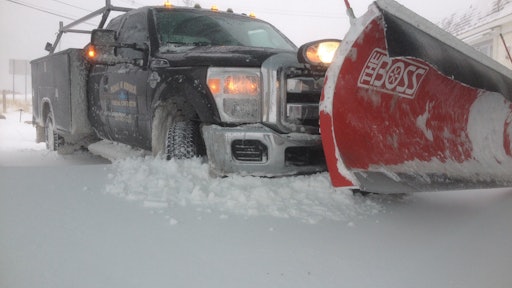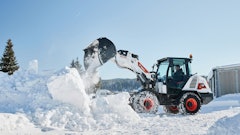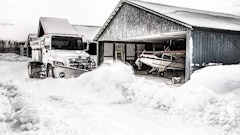
Snow removal is most certainly a "reactive" business; crisis management at its best. It snows and you go to work. The difference between the really successful snow pros and those who get eaten alive by winter's unmerciful wrath, though, is how "proactive" they are in preparing for that work.
Domenic A. Chiarella can testify to this from firsthand experience. He served as director of operations and business development at one of the most creative and collaborative organizations in the New York and Connecticut areas, Ultimate Services Professional Grounds Management Inc. He grew his landscape/snow business to $15 million within 10 years. You cannot do that without a good handle on how to manage production.
Even if you aren't a massive company, it's still essential to have a good handle on production. "When you figure out how much your company can realistically produce, you can also identify what could hurt you if you over-sell," Chiarella says. "Then, you have to prepare every single person in your company so that each department can produce at a high level, all working together as one company from pre-season to post-season."
Chiarella refers to this as "know thy company" and "connect thy company." They are the two key components to creating a highly efficient, growth-oriented snow removal company. In addition, there are three simple words that, when executed properly, can help you satisfy both the client and your company: pre, during, post.
"You have to develop pre-, during- and post-season systems, along with pre-, during- and post-event systems," Chiarella points out. "These interdepartmental systems help keep a reactive, highly demanding business from getting the best of you and your bottom line."
Chiarella says these systems are surprisingly simple to implement but seldom used by the smaller snow provider. That's why he classifies them as among the best kept secrets of top snow removal companies.
Secret #1 – Know Thy Company with Capacity Boards
Production capacity boards represent one of the most important pre-season systems you can implement. As the name suggests, a production capacity board helps to define your production capacity. "With just three boards, a company can realize the difference between making money and not making money," Chiarella says. Your three essential boards should be for:
- Trucks and equipment
- Deicing materials
- Labor
Equipment capacity board. "In one company I'm working with, we are building an equipment capacity board," Chiarella tells. "We've listed every truck in the fleet, along with what plow or spreader is on it. We've also listed the other large equipment that can be used to manage snow. This is providing a clearer picture of what our production capacity is, in terms of how many acres we can plow and provide ice control for."
To bring that picture into even clearer focus, you also need to understand some basic production metrics. Chiarella thinks back to his earlier years as an up and coming snow removal contractor. "I knew I had eight trucks, and each could log about six hours of plowing for every snow event. I also knew that each could plow about an acre per hour, on average. So I was confident we could handle right around 50 acres (8 trucks x 6 hours/acres = 48 acres)."
Of course, production capacity (i.e. acres per hour) will likely vary from truck to truck, plow to plow and spreader to spreader, etc. So you need to have a good understanding of each piece of equipment's capability—which could further be affected by the operator himself. This helps illustrate the importance of a second stand-alone production capacity board: labor.
Labor capacity board. "You need to identify who your labor is and what they are capable of doing," Chiarella points out. "This is paramount to building routes that work for your company." For example, if you have a track loader with 10-foot box plow, that doesn't do you much good if you do not have an employee who can operate it.
Materials capacity board. Finally, you should have a separate capacity board for deicing materials—especially given all of the salt shortages in recent years. Use history as your guide to develop this board. For example, if you generally need a ton of salt to treat an acre, and have 14 acres to treat, you need 14 tons of salt per event. Then, if previous seasons suggest that you'll have to treat your properties X number of times, you can start to get an idea of what your overall materials needs will be.
"You also need to note where you'll be getting your materials from and/or where you'll be storing them," Chiarella adds. Your ability to procure and deploy deicing materials is pivotal when it comes to deicing capacity.
Secret #2 – Connecting All Departments in Your Company
Creating these pre-season production capacity boards represents the exercise of getting to "know thy company." Doing so also allows you to begin to "connect thy company."
Remember when we said Chiarella's eight trucks could plow about 50 acres per event? This gives the sales team something to sell. Additionally, if they sell more than 50 acres, it's immediately exposed that the company is going to need to increase its production capacity, through the acquisition of more trucks/equipment/employees/materials, or maybe subcontractors.
"Imagine a company where your sales department knew exactly how much to sell, your production department knew that it could perform the necessary work during every snow event, and your accounting department bills the client correctly each and every event," Chiarella says. "Capacity boards are a simple tool that can help make this possible."
Two other valuable tools are pre- and post-season work orders. These documents further enable you to connect all departments in your company—sales, production and administration.
Pre-season work orders. As soon as a contract is signed, you should begin creating pre-season work orders for that property. It's a good idea to create separate ones for production and accounting. That's because production and accounting might need slightly different information, namely the physical address. Wouldn't it be disastrous if your plow truck drove to the client's main office, where the invoices are to be sent, when the truck is supposed to be plowing another one of the client's properties on the other side of town? Additionally, your accounting department may need different contact names and certain contract stipulations more specific to invoicing, etc.
As for production, they need to know what the contract says they need to do to service the property. According to Chiarella, one thing some contractors fail to do is thoroughly evaluate a property before establishing the contract. Some even neglect to meet with the client!
"Don't neglect preparing the property," Chiarella advises. "Look for tricky areas to the job. Identify where you can and can't use certain types of deicers. Identify where you are going to be piling the snow. Take photos. Also, ask the client about important days and times in the property's schedule, such as key delivery days, when employees come and go, store hours, etc. All of this will help you get a much clearer picture of what it is going to take to service that property."
Chiarella recalls a time meeting with a new client when he was still a contractor. "One of my new clients met with my whole team before the snow season started. We introduced who was going to be doing the work and who was going to be a contact person for any questions. As my production crews were busy staking the properties and taking photos of the area, my salesperson and I were discussing the site with the property manager. After just a few minutes, a problem became apparent with the contract.
"The contract, which was done at a national headquarters, had some glaring holes in it—at least in the eyes of this property manager who was used to his way of servicing a property," Chiarella continues. "There was no way we would be able to service this property with the contract we had in our hands. We gave the contract to the property manager to help him understand what work we could and couldn’t do. He not only found a way within the parameters of the contract, but also found a way to pay us for the extra work area to satisfy his way to service the property."
Post-season work orders. Pre-season preparation makes scenarios like that possible. Post-season work orders, for similar reasons, are also very important.
"When you close up shop for the season, you need to go back to the property to take the stakes out," Chiarella says. "You also may need to get final sign-off on some paperwork. Spend some extra time talking with the client. Were they pleased with how you performed? Is there anything you could do better, differently or additionally? And here's another big secret of top snow companies: Have a contract renewal in your hands. If you did a good job, there's a good chance you can get a contract signed right away for the following season."
Secret #3 – Satisfying Clients Event by Event
Systems for pre- and post-season planning can help you take your company to another level. But as hard as it might be to believe, many contractors also fail to plan during the season. Chiarella outlines several important considerations and questions you need to ask yourself.
When a snow event is on the way, who is part of the preparation?
- Accounting – prepares paperwork
- Operations – prepares the equipment
- Production – provides labor and management to service properties
- Owners/management – they're just along for the ride ... right?
"To prepare for a snow event, conscientious management teams will hold meetings with their employees," Chiarella says. "That way they can solve any issues days before a storm, not minutes. You know what work needs to be done. So review how it has to be done, when it has to be done, along with all of the little details of each site. Most issues can be resolved before an event takes place. In this case, a little preparation does go a long, long way."






























